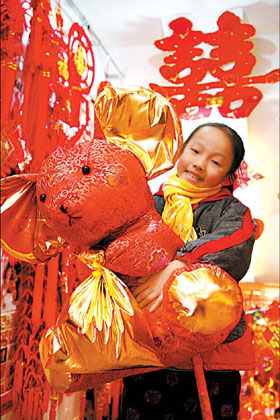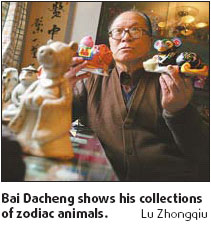The Spring Festival in early February means a long, joyous and relaxing holiday for many.
For folk artist Zhao Caixuan, 64, however, the boom business season is yet to come.
A girl with her newly bought mouse toy at a shop in Guizhou province. Qin Gang
Over the past weeks she has been busy doing paper cuttings featuring mouse figures at her studio in Baigongfang, a complex where many folk artworks are on sale in southern Beijing.
Her customers include both Chinese and foreigners in Beijing, according to Zhao, a retired professor of ancient Chinese history from Hebei province, who learned from her parents the centuries-old art of paper cutting.
"The Year of the Mouse is coming. More and more people want mouse-themed paper cuttings, to be used as either Spring Festival gifts or home decorations," she explains.
She sold at least 5,000 paper cuttings featuring pigs (the Chinese zodiac animal for 2007) during last year's temple fair at Ditan Park, one of a dozen annual, traditional, festive gatherings in Beijing during the Chinese lunar New Year celebrations.
Zhao makes paper cuttings featuring zodiac animals all year round. But "the Spring Festival holiday is the best time for me," Zhao says with a smile.
Zhao is not the only one taking advantage of the craze for zodiac animals.
Since last November and December, all kinds of products featuring mice have appeared at markets.
Among the most eye-catching local products are gold bars and coins, stamps, toys and sweets bearing or resembling the image of mice.
"Gold products featuring zodiac animals have become more popular among customers," says Li Xiang, a manager with the Caibai Gold and Jewelry market, the biggest of its kind in Beijing.
At least 3 tons of pure gold products sold out in 2007 at the Caibai market, while in 2001 less than 1 ton of pure gold products were sold, he says.
"Apart from investment purposes, the lovely mice add to the festive atmosphere," says a customer surnamed Liang who came with his girlfriend to buy mouse-shaped gold products for family members.
For young people like Mi Dong, a high school teacher, mouse-shaped toys are also a good choice for New Year gifts.
"Some like Mickey Mouse and Minnie Mouse; but I prefer Chinese style mouse toys, especially those dotted with traditional patterns and motifs, such as ancient gold coins," says Mi, who bought several mouse-shaped hairy toys. The most expensive one cost him over 50 yuan ($7) in a toy store near Di'anmen in downtown Beijing.
"To enhance the New Year atmosphere, many people buy adornments with mouse images to decorate their room, such as mouse-shaped saving boxes, calendars with cartoon mice pattern, New Year cards and red envelopes for their kids' pocket money," says Wang Fang, a salesman at the Panjiayuan Antique Market, where mouse-themed products are available.
For stamp collectors/speculators, the Year of the Mouse came with a bit of a surprise.
Qiu Lihua, like many stamp collectors, bought the first day cover, which featured a misspelling of the Chinese character for "mouse."
"This might be a good omen. So I bought 60 sets of them," recalls Qiu, who bought each for 2.2 yuan on Jan 5 but sold many of them for 40 yuan each just days later at the Madianqiao Philatelic Market.
"Chinese have long developed an emotional attachment to the mouse, the first of the 12 zodiac animals indicating a cycle of 12 years on the Chinese lunar calendar," says Bo Songnian, a folk art researcher with the Central Academy of Fine Arts.
Archaeological findings of the last century have shown that images of the mouse first appeared on bronze ware in the Shang and Zhou dynasties, more than 4,000 years ago. Whether it is stone sculptures in the Han Dynasty (206 BC-AD 220), clay and wooden sculptures in the Sui and Tang dynasties (AD 581-907), and gold, silver or porcelain products in the Ming and Qing dynasties (1368-1911), the images of mice or rats have been popular.
Actually, ancient Chinese had a love-hate attitude toward the mouse, he notes.
Sometimes, mice and rats were depicted as mean, greedy, sly and disgusting creatures. For instance, in the ancient Book of Poems, people compared corrupt officials to mice that ate their grain.
But at the same time, people worshipped mice and rats for their unusual reproductive capabilities. Hence, the images of mice or rats appeared in households as auspicious decorations, implying fertility and prosperity in a family.
"On one hand, some people dislike, or even fear mice and rats, as the rodents damage houses, spread diseases and spoil the food," explains Bai Dacheng, a veteran folk artist/collector in Beijing.
"On the other hand, the existence of mice or rats in a house may imply that the family is rich and prosperous."
"In some areas in southern China, the mouse has become an animal with mysterious power, and is even considered by many to be the god of fortune," he says.
Bai is better known for his zongren (bristle figurines) art, featuring vivid, moving Peking Opera figurines.
He has collected zodiac animals for more than two decades.
During his spare time, Dai roamed almost all the antique markets in Beijing and neighboring cities, buying folk art works, many of them featuring zodiac animals.
Of them, Bai has collected more than 200 mouse-themed folk art works, ranging from clay sculptures and wooden sculptures to embroidery and clothwork, as well as metal utensils.
The oldest mouse-shaped, pottery utensil in Bai's collection was created by a folk artist of the Han Dynasty.
Based on his years of collecting experience and research, Bai has designed his own editions of zodiac animals. This year, he has brought out two versions of painted clay mice, both featuring traditional Chinese motifs.
For many, the zodiac animals also represent one's personality, according to Zhang Tongli, a salesman at an antique shop near Longfusi Street in downtown Beijing.
If one was born in the Year of the Mouse, then he or she is artistic, talented, charming, opportunistic, energetic, sometimes unscrupulous, yet usually successful, according to horoscope theories, he explains.
In recent years, the 12 zodiac animals in Chinese culture have also attracted the attention of overseas designers and collectors.
Stamps featuring mice and the Chinese character for the mouse have reportedly been issued in Canada, New Zealand, Australia and Singapore, as the Year of the Mouse approaches.
"This may indicate that the influence of Chinese culture is increasing worldwide as China is playing a bigger role in the international arena," says Zhao Guangming, a folk art researcher in Beijing.
Paper cutting works by Zhao Caixuan. Lu Zhongqiu
(China Daily January 31, 2008)




